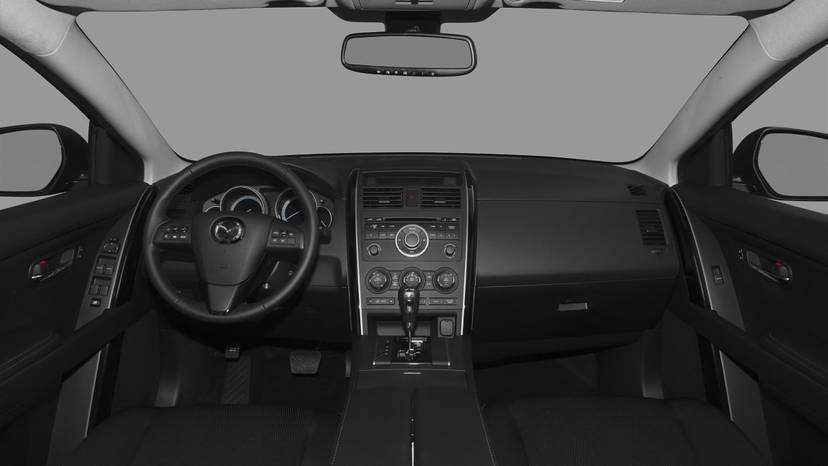
Editor’s note: This review was written in May 2010 about the 2010 Mazda CX-9. Little of substance has changed with this year’s model. To see what’s new for 2011, click here, or check out a side-by-side comparison of the two model years.
If you want an SUV with seven or more seats, your options start with compact crossovers — whose optional third-row seats are best left for punishing kids — and end with full-size truck-based SUVs, whose exterior bulk and gas mileage are punishing in their own right. In between is a healthy selection of mid- and full-size crossovers that includes the 2010 Mazda CX-9.
In a crowded class, the CX-9 distinguishes itself with a high-quality interior and more driving fun than you’d expect from a large, seven-seat crossover.
Competing on the small end with the seven-seat Toyota Highlander and on the large end with the Chevrolet Traverse, the CX-9 comes in three trim levels: Sport, Touring and Grand Touring. Front- and all-wheel drive are available at all three levels.
Exterior & Styling
Compared with its competitors, the CX-9 is pretty sleek-looking for a large crossover. Most crossovers are more streamlined than Ford’s boxy Flex, but even those cars have vestigial characteristics from the SUVs from which they evolved — sort of the way some people have a prominent brow ridge from Neanderthals past. (Or so it seems, depending on whom you hang out with.)
For 2010, the CX-9 has joined its happy Mazda brethren by adding a larger, smiling grille, as well as restyled headlight clusters and fog lamps. There are a few changes to match around back, but the most functional change comes in the form of larger side mirrors, which Mazda says are also more aerodynamic. Oddly, only on the Grand Touring trim level do the side mirrors have turn-signal lights. The Grand Touring has xenon headlights, chrome rather than body-colored door handles and 20- rather than 18-inch alloy wheels. Frankly, I think automakers have gone overboard with the giant wheels, though they make more sense on a vehicle this large than they do on cars. Owners might throw themselves overboard when they find out how much it costs to replace large wheels and tires, though: According to TireRack.com, the standard 20-inch tires cost $217 apiece; the 18s are $182 each. (You can get different brands for less, but this gives you an idea of the original-equipment price range.)
On the Road
Even with its 20-inch wheels, our Grand Touring rode reasonably comfortably, but it’s a bit firmer than some. With that firmness comes pretty entertaining handling, with precise steering and a good feel to the wheel. While I’d characterize the CX-9 as one of the sportier three-row crossovers out there, don’t get the impression that it’s a sport wagon. It’s large, and opportunities to drive it in a spirited fashion seldom present themselves.
The CX-9’s acceleration truly surprises, especially in a Grand Touring weighed down with all-wheel drive and lots of features. Teamed with a six-speed automatic transmission, the 3.7-liter V-6 has plenty of power: 273 horsepower and, perhaps more important, 270 pounds-feet of torque, which gives it an urgent launch from a standing start.
On slick surfaces, I noticed some initial front-wheel slip before the traction control kicked in and the rear wheels played their part. Some all-wheel-drive systems are more seamless. In the practical sense, this quirk is of no consequence to most drivers.
Interior
For its exterior size, the CX-9’s cabin is a bit snug. Its passenger volume is 139 cubic feet, which is smaller than the seven-seat Highlander (146 cubic feet), the Traverse (154 cubic feet), the Flex (156 cubic feet) and the Honda Pilot (154 cubic feet), the last of which is shorter from bumper to bumper than the CX-9 but wider and taller. The CX-9 just edges out a couple of other seven-seaters that are smaller on the outside: the Hyundai Veracruz (137 cubic feet) and Subaru Tribeca (133 cubic feet).
Where I feel the difference between the CX-9 and its larger competitors listed above is in the second- and third-row seats. By the numbers, the second-row seat has generous legroom, thanks in part to roughly five inches of fore/aft adjustability in the seat. In practice, I found myself sitting closer to the floor than I like, with my knees raised considerably.
The third-row seat is more typical in this regard, and its legroom measurement is average. It all depends on how far forward the second row is. Headroom, however, is limited: It’s lower than its competitors by about a half-inch to three inches, depending on which model you compare it with. At 6 feet tall, I barely fit back there even when slouching. Third rows are generally intended for kids; just be aware — if you have a large brood, a generous growth spurt could put your wayback out of commission.
The geometry of all the seats might not have worked well for me, but the front seats themselves are very comfortable — appropriately padded for short or long trips. We made a run from Chicago to Detroit with minimal fatigue. The interior quality is definitely above average in this model. You might attribute this to the high trim level we tested, but just because a vehicle has leather upholstery (as the Touring and Grand Touring do) doesn’t mean it’s high-quality. We’ve criticized the Flex Limited for exactly this problem.
I wasn’t wild about our test model’s faux-wood trim, but the materials are generally high-quality. I prefer the piano-black accents that are standard on the Sport and Touring trim levels. Though we didn’t test the base trim level, Mazda says 2010 versions have new cloth upholstery. Also new are chrome accents on some of the knobs, door handles and trim. The storage console between the front seats is reasonably roomy, but I don’t like the new barn-door lid design. I suppose in theory your passenger can keep an arm rested on one side while you open the other, but in practice the raised door blocks your access, and you’ll probably end up opening both anyway. Some might find this design less cumbersome than a single, flip-back lid. Not I.
Safety
In Insurance Institute for Highway Safety crash tests, the CX-9 earned the top score, Good, in frontal and side-impact tests. It hasn’t been tested for rear impacts or for roof strength, an indicator of rollover protection. The CX-9 isn’t alone with its good scores; the IIHS Midsize SUV class into which it falls is packed with high-scoring models.
The CX-9 has two airbags in front, and front occupants get seat-mounted side-impact airbags and active head restraints. Side curtain airbags protect all three rows of seats in a side impact and are also designed to deploy in the event of a rollover. Also standard are antilock brakes and an electronic stability system with traction control. The CX-9’s stability system is supplemented by Roll Stability Control, a feature developed by Volvo and later incorporated into then-parent-company Ford’s family of SUVs. It’s the only system that senses when a rollover has begun and employs the stability system in an attempt to forestall it. Similarly described features on other cars act only in conditions that can lead to a rollover.
A blind spot warning system is standard on the Grand Touring but not offered on lower trim levels. A backup camera comes with the navigation system that’s optional on the Grand Touring. You can get a backup camera without navigation on both this model and the Touring trim, but unfortunately it’s packaged with other features. To see all the CX-9’s safety features, click here.
Cargo & Towing
With 17.2 cubic feet of volume behind the third-row seat, the CX-9’s cargo capacity is midpack, but its maximum with all rear seats folded is on the higher side of its class.
| Three-Row Crossover Cargo Volume | ||||||||||||||||||||
|---|---|---|---|---|---|---|---|---|---|---|---|---|---|---|---|---|---|---|---|---|
| Behind third row (cu. ft.) | All rear seats folded (cu. ft.) | |||||||||||||||||||
| Mazda CX-9 | 17.2 | 100.7 | ||||||||||||||||||
| Chevrolet Traverse | 24.4 | 116.4 | ||||||||||||||||||
| Ford Flex | 20.0 | 83.2 | ||||||||||||||||||
| Honda Pilot | 18.0 | 87.0 | ||||||||||||||||||
| Hyundai Veracruz | 13.4 | 86.8 | ||||||||||||||||||
| Subaru Tribeca | 8.3 | 74.4 | ||||||||||||||||||
| Toyota Highlander (7 seats) | 10.3 | 95.4 | ||||||||||||||||||
| Source: Manufacturers | ||||||||||||||||||||
The cargo area is accommodating, but there are a few quirks. The liftgate should raise higher to ensure noggin clearance. Also, there’s no provision to cover the gap between the folded second and third rows, as there is in some cars with sliding second rows. The greater shortcoming, though, is that the second row’s upholstery wraps over the top of the backrest and extends a quarter of the way down the back. As a result, when you fold the seat down, a segment of your cargo floor is leather rather than carpet. It’s easily damaged.
As equipped, the CX-9 can tow up to 2,000 pounds. With the Towing Prep option package, the maximum increases to 3,500 pounds, which is average. When properly equipped, the Flex can tow 4,500 pounds, and the Traverse is good for 5,200 pounds.
Features
Standard features not already mentioned include power windows and locks with remote keyless entry, air conditioning, cruise control and Bluetooth cell-phone connectivity. The Touring trim level adds power, heated front seats. The Grand Touring adds three-position seat memory, rain-sensing wipers, an alarm system, HomeLink, an auto-dimming rearview mirror, and keyless entry and engine start. New for 2010 is a conventional keyfob, replacing the old credit-card style transmitter, which was a neat idea that never really worked out.
The Sport offers heated, power front seats as an option. Touring options include a power liftgate and a package that includes a moonroof, Bose premium stereo with Sirius Satellite Radio, and a backup camera. The Grand Touring offers a backseat entertainment system packaged with the Bose premium stereo option.
All the CX-9’s options can be viewed here.
CX-9 in the Market
Considering the Pilot and Highlander once had this field to themselves, the class of large three-row crossovers is one of the most competitive in the market. Those two pioneers reflect the refinement that comes from a couple of generations of steady improvement, but what’s surprising is that the more recent additions have hit the market with competitive quality and feature offerings that we never saw when automakers stumbled their way into the compact-crossover category. The Highlander, Pilot, Veracruz, CX-9, Flex and Traverse are all Cars.com Best Bets. That means you have plenty of choices, and frequent incentives and good deals await.
| Send Joe an email |













































